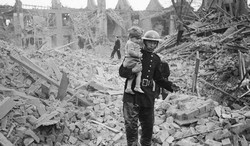Kristin Bluemel, professor of English and Wayne D. McMurray Endowed Chair in the Humanities, was interviewed by Handheld Press about her literary contributions to forgotten work by World War II-era writer, Inez Holden, on Monday, Mar. 8.
Bluemel worked as an editor for Holden’s novel “Night Shift” and her memoir “It Was Different at the Time,” both about ordinary people living through the Blitz, a German bombing campaign against the United Kingdom in 1940 and 1941.
“Night Shift” describes six consecutive nights, primarily in a factory that is manufacturing parts for reconnaissance planes during the war and “It Was Different at the Time” is based on Holden’s actual diaries she kept throughout the Blitz.
Both sets of writings were republished together in “Blitz Writing” by Handheld Press of Bath, England, in 2019. “‘Blitz Writing’ is essentially two books wrapped into one very tidy and attractive package,” Bluemel said.
Handheld’s publisher and London historian Jerry White joined the conversation to provide his perspective.
Kate MacDonald, literary historian, editor, and director of the Handheld Press asked Bluemel why Holden was writing a diary and novella at the same time on the same subject.
“I think people who maintain extensive diaries are compelled to do so,” Bluemel said. “There are multiple volumes of this diary. It was not isolated to the months or years of war. Holden was a storyteller. She used the materials of her life to inspire her imagination and to communicate with people.”
It is known that Holden wanted to be a published writer, as many of her acquaintances were writers, Bluemel explained. “She had an extraordinary assemblage of cultural figures and prominent personalities who were her friends and her associates. She was inspired and she wanted to clearly share her vision and her storytelling; her astonishing knack for mimicry of voices and her ear for conversations with the public.”
“Night Shift” followed next, a story of working people doing ordinary things, something that was rarely published, Bluemel explained. “It’s really an extraordinary document, I believe, of ordinary life during the Blitz outside of London.”
White joined the conversation to offer input on other writers documenting the Blitz who published works during the same time period.
“There are a few novelists and diaries who are publishing at around the same time,” White said.
“Well-off journalists and writers are writing diaries because they know everybody’s going to be interested in them. They’re seeing and telling history as it’s happening.”
Journalists and novelists of the time were publishing with an eye to an American audience, offering the plight of Britain to win the sympathy of America. “There’s quite an industry of writing about London.” White continued. “If you take [these] books together, Holden is a unique witness of the aspects of the wartime economy in particular, not just of London.”
“Night Shift” was Holden’s fourth novel, her earlier three works were products of the late 20s and 30s, MacDonald explained. “Then there’s a pause,” MacDonald said. “Is that pause because she was writing short stories or was focusing on journalism?” MacDonald asked Bluemel. “I’m interested in how ’Night Shift’ evolved within her own context.”
Holden’s early novels were much different from her writings during the Blitz, Bluemel explained.
“There’s the same knack of recording dialogue, but with completely different sets of social and cultural concerns,” Bluemel said. “I’m drawn to [her] wartime books because I’m drawn to literature of work. Most of us work all the time and it’s never in our literature; even if we’re writers we’re working.”
Holden came from an elevated family with a significant ancestral role in county society, Bluemel explained. She did not often imagine her life as a worker or somebody in sympathy with factory workers.
“It’s that kind of culture that couldn’t be more different from the working class people and particularly the working class women who are on the factory line.”
IMAGE TAKEN from Financial Times




